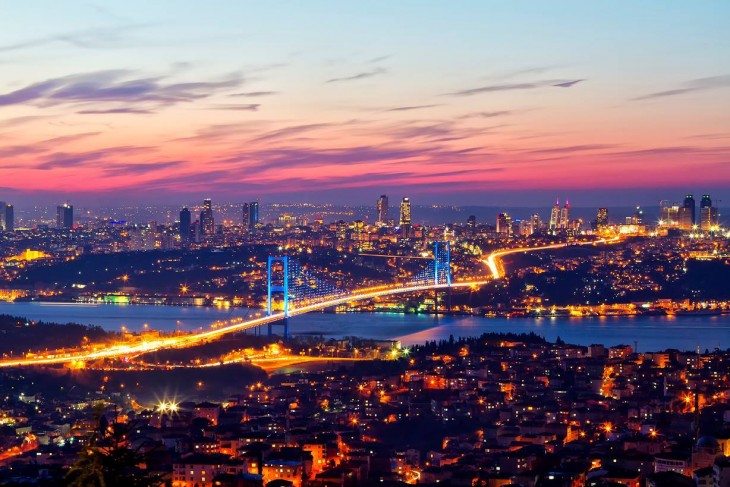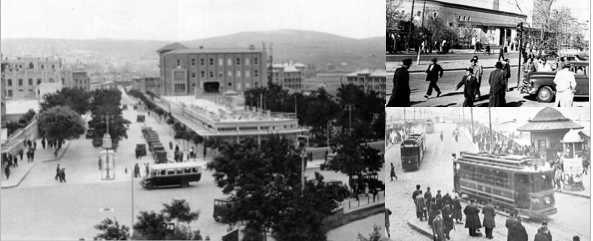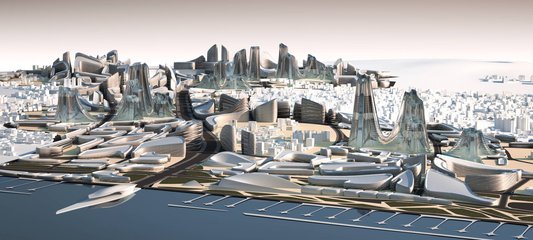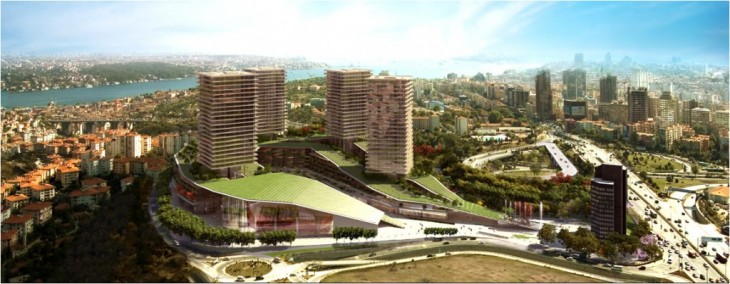In the twentieth century as the capital of three old empires, Istanbul was standing out as an imperial city. After centenary years, Istanbul has finally put its name on the map as a global city which forms a relationship between dominant economies and rest of the world’s. Urban spaces redesign themselves each day in Istanbul just like the other metropoles because of different profit acts by different interest groups. This geographic development is also acts a dominant part of the city’s urban design and architecture. Considering these developments have their own specific architectural needs, an architect’s role becomes not just a usual, a multidisciplinary practise. The definition of an architect’s role starts to change into sometimes just one or mix of these new roles such as bureaucrats, constructors, businessmen, academicians, activists etc. So in what extent the role of an architect changed in these recent years? Seeing their appearances on these prestigious billboards of real estate advertisements, how the conception of an architect changed over 10 years in Turkey, especially in Istanbul?
Social responsibility exists in the foundations of being an architect, however at the present Istanbul, architects are just sidekicks in designing an urban space. They supposed to be the main particle of this medium but sadly, their role of producing is limited in only 2 of world’s architecture and urban design. Architects gives to themselves these huge responsibilities, even so their roles were already limited by their financiers or clients. In this case, architects starts to wait for their perfect employer/client who understands architect’s ideals and ideas. According to Lefebvre, in this capitalist system, from now on, designing a space is a meta(commodity).
In today’s Metropolises, designing and producing an urban space or an element can not be under control of just one discipline. As a result of this situation in Istanbul, architect is the weakest and smallest section of client- constructor- architect trio pie because in order an architect can capable to work, he needs a client to invest his ideas. However in Istanbul, clientele is mostly imposing their ideas without having any comprises. First, architect has to struggle with the client in the designing process. The investor is willing to invest in a building of several thousands of square-meters, not considering of its architectural and / or social values that bring within but only regarding that this project will assure him profits. Later, he faces with the constructor about economics, and some structural practices related to that design. In this case, economics acts as one of the key factors should determine priorities, the importance of projects that are invested and the other one is the given time; there are plenty designs out there which ignored its sustainability plus green design qualities, just because they might not be profitable to complete in such limited time. This identity of businessman/woman on architects challenges with architect’s intellectual, creative persona. In this context Mark Wigley, underlines that at first, architect is an intellectual, he creates speculations with words through images. Basically, architectural design offices jobs are first to produce a lot of concepts and words then connect them to each other within a contextual way. In this point, the conflict on the concept of contemporary architects is designing relaxation spaces in this living organism called city. As U?ur Tanyeli stated in his books named Mimarl???n Aktörleri, if these attitudes created by these active components (mentioned at top) in the city is questionable, rather than accepting them, this action-reaction game becomes more creative and of course useful.
Before focusing on contemporary architecture in Istanbul, it is important to know at least few thing about Turkey’s architectural historic state of mind. The concept of the architecture in early republic era was supported mentally and financially by government because it was important factor to build up a new capital at Ankara in those years.Owing to the fact that era was after World War I, Ankara was started to develop around Castle of Ankara with a limited finance and economy. Designers of these tries of creating another metropolis, were either bureaucrats or foreign consulting architects while ?stanbul was not defined as popular by Early Republic era’s elite society. Back in those days, government which was the only supporter of architecture, was not aware that architecture is a social service that can easily get commercialised. Unfortunately between 1950-80’s, architects started to get rid of all those social responsibilities or values that they carry in their minds and they became less involved in construction and production phase of architecture. Also, there were two types of housing mainly can be observed at that time period which are “built-sold” mass housing which designed by constructors for middle class and “gecekondu”s. After the adaptation to consumerist capitalism, perception of beauty becomes luxurious, and for clients, beauty and “designed” tags became more important than ever. With this phenomenon, identity and name of the designer transformed into a brand. Nowadays, large investments have more intimate relations with the construction sector in Turkey. Presentation techniques, production and fabrication started to differ that usual, they developed into a more industrial, also more commercial base. Investments are getting bigger with the scale of the projects. Architectural products started to be designed with a more organised team work instead of one’s artistic work. While new types of communication, informatics and transportations are rising, information, wealth and people are progressively changing. Keywords such as flow, movement raised and new types of industries starts to exist such as informatics, communication, service, advertising, and prestige. At this point, global wealth is the key factor for urban structuring. From now on, the way of modernising spatial organisation is not the cities built in a hierarchical order around the main authority, but the cities who survives under the global wealth without being in the same context by their countries and locals. To summarise a bit, today’s urban patterns are defined as collateral but with a broken connection, the key field who has the biggest investments is becoming construction sector. With this new patterns in city, investor decide to provide their capital for bigger scaled projects which has a bigger prestige with mixed used functions and fictional lifestyles. In these gated communities, buildings are just a little part of the project, main advertising mostly goes to this mixed used function perception. Back in the days, lands itself were worthy, now it is only bringing gilts to the project. The increasement of these gilts are related to the threshold of the city’s value and life quality that it provides to habitants. From now on, new Istanbul is not a place for “flaneurs” anymore. In this context, EAA’s Zorlu Centre and Zaha Hadid’s Kartal Urban Transformation projects can be given as examples.
Zorlu Center which is located on the one of the most developing axes of the Istanbul city, it has a unique land build on a hillside with its 96.000 square-metes area. It sustains residential, tourism, stores, offices, socialising space definitions within its complex. In early 2007’s, with its presentation of design competition to vox populi of Istanbul, investors tried to gain more prestige from the project. However in Zorlu Center’s later stages of production, architects could not involved as they were at the competition time period. So there were two main questions needed to be asked, first, who owned the last words at the design and fabrication process for this project between employer, investors and architects, secondly, can the idea of a designing a public square in a privatised complex be successful? Plus, it also must be questioned that the changing silhouette of Istanbul too. In addition to this example, Zaha Hadid’s Kartal Urban Transformation Project has also same issues. this project selected after a competition with a ‘starchitect’ signature however after designing process , her visions with this project and Istanbul’s master plan criterias differed and sadly her name in the project is only played a role in advertising it.
In conclusion, it can be mentioned that organising design competitions for this kind of larger scaled projects is really important for the role of architect in this world. However if architects continue to act their small role in this medium and their visions and missions about their projects can not be projected to the fabrication process, then these projects can not be successful nor have long gilts to the investors as in an economic perspective.The most importing thing about architecture is that architecture creates a habitat for human race, in this ideal labels and short term economic profits should not be matter. As long as, people does not questions the role of architect, Istanbul’s being a playground for some others is inevitable.
References:
- Gamez & Rogers, “An Architecture of Change”. Expanding Architecture:Design As Activism: ed. By Bell, B.& Wakeford, K., 2008 Metropolis Books, N.Y.
- R.Katz, “Finding Balance: How to be an Architect, an Environmentalist and a Developer”. Expanding Architecture: Design as Activism: ed. By Bell, B.&Wakeford, K., 2008 Metropolis Books, N.Y.
- Henri Lefebvre, “The Production of Space”, Oxford: Blackwell,1991.
- Mark Wigley, Resisting the City”; Transurbanism, ed; Arjen Mulder, V2 Publishing / NAI Publishers, 2002.
- U?ur Tanyeli, Mimarl???n Aktörleri: Türkiye 1900 – 2000, Garanti Galeri, ?stanbul, 2007.
- Tuna Kuyucu, “Bir Mülkiyet Transferi Arac? Olarak Toki ve Kentsel Dönü?üm Projeleri”; ‘Osmanl? Ba?kentinden Küreselle?en ?stanbul’a: Mimarl?k ve Kent’, 1910-2010. Ed. ?pek Yada Akp?nar. III. ?stanbul Sempozyumu Yay?n?.
- Saskia Sassen, The Global City. Princeton University Press, Princeton,2001
Role of Architects in Globalised Istanbul is a project of IaaC, Institute for Advanced Architecture of Catalonia developed at Master in Advanced Architecture in 2015 of the Academic Program by:
Student: Lalin Keyvan
Faculty: Gonzalo Delacamara




